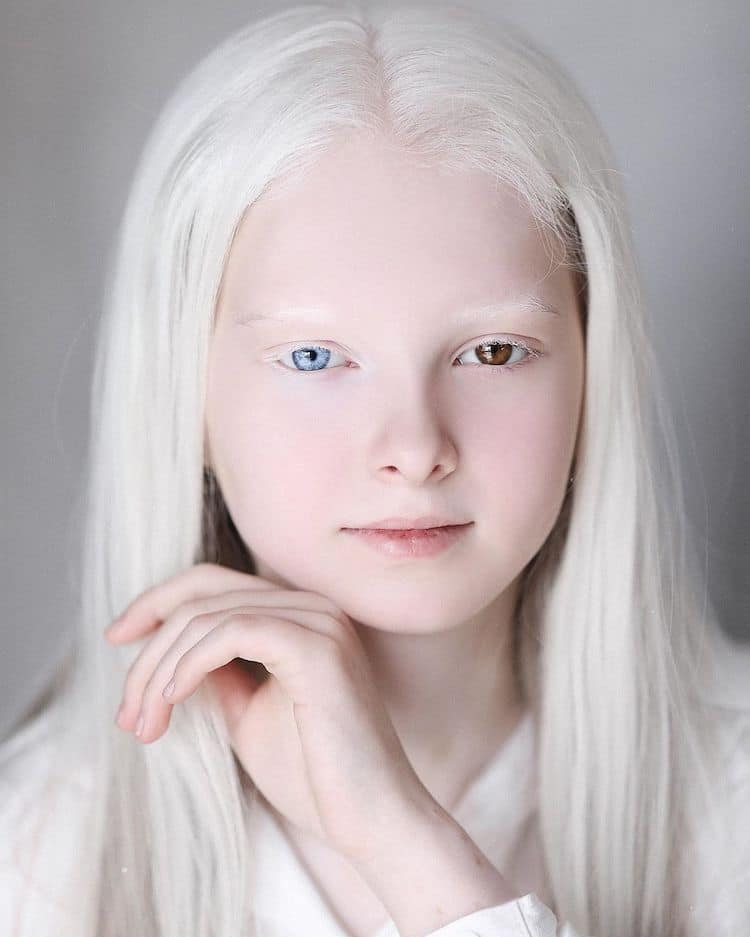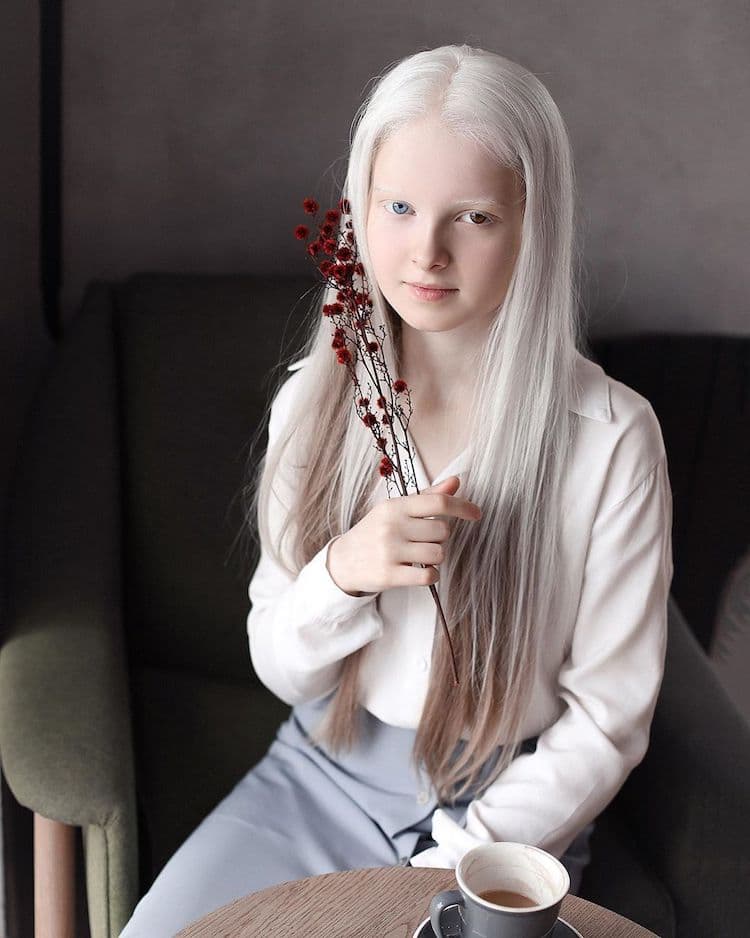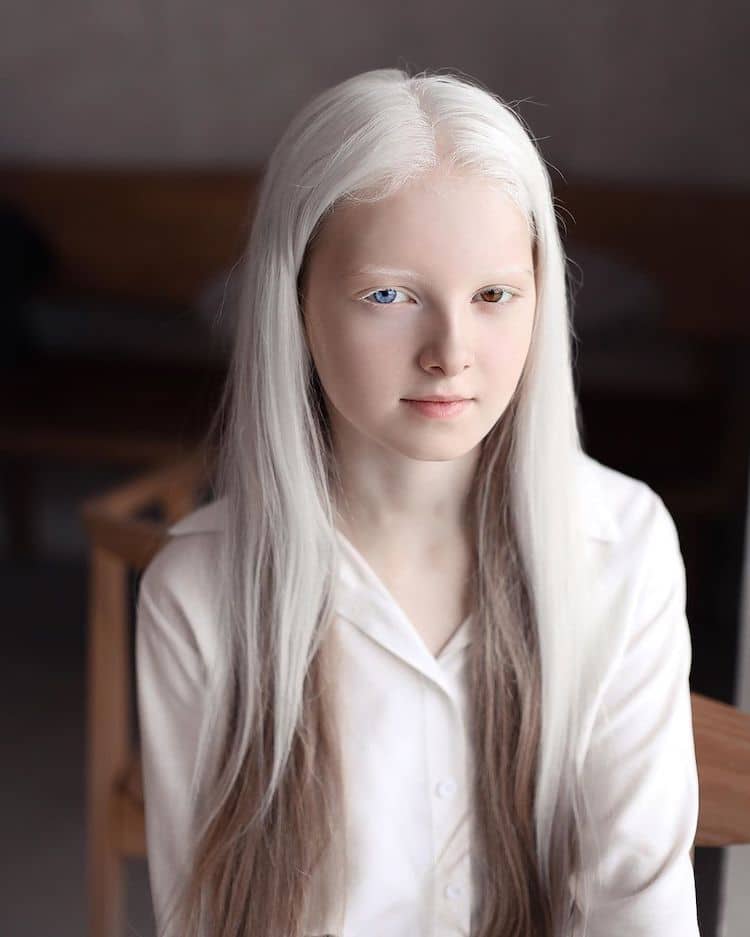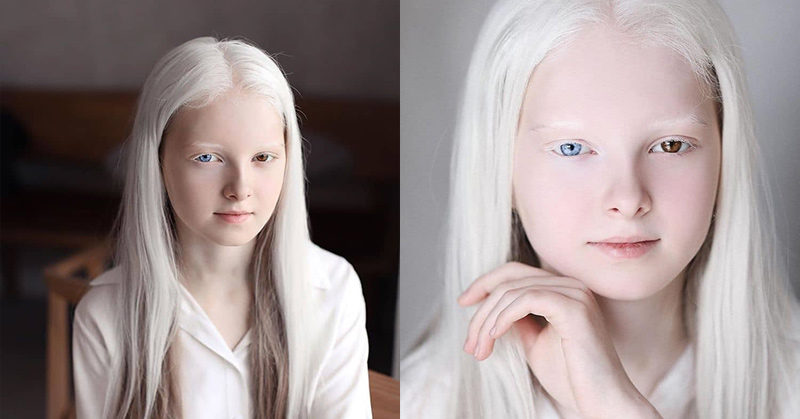Albinism is a very rare condition and occurs in only about one in every 20 thousand people in Europe and North America [1]. Heterochromia is also rare, with only about six in every one thousand people with the condition [2].
For this reason, when a photographer from Chechnya, Russia, saw a picture of a young girl with both conditions, she knew she had to meet her- and take a few photos, of course.
Amina Ependieva: A Rare Beauty
Photographer Amina Arsakova saw the picture of eleven-year-old Amina Ependieva in a shopping center, and was immediately stunned by the young girl’s unique beauty. Ependieva has both albinism and heterochromia, both of which are rare on their own, let alone together [3].
Albinism is a condition in which there is little to no melanin production in the skin. Since melanin is responsible for the pigmentation of skin, hair, and eyes, individuals with the condition have very pale skin and white-blond hair [4].
Heterochromia is another genetic condition that causes a person’s irises to be different colors [5].

Because of her two conditions, Ependieva has quite a striking appearance, with her fair-colored skin and hair, one brown eye, and one blue eye.
After some searching, Arsakova was able to contact the girl’s mother, who agreed to set up a photoshoot for her daughter. Arsakova described the young eleven-year-old as having a very calm nature, a trait that is reflected in her photos [3].
What is Albinism?
Usually when we talk about albinism, we are referring to a condition known as oculocutaneous albinism, which is a group of inherited disorders that affects melanin production in the skin and hair. It is caused by the mutation of one of the genes that provide instructions for making the proteins that are involved in melanin production.
Other types of albinism include ocular albinism, which is mainly limited to the eyes, as well as albinism related to a hereditary syndrome.

Melanin also plays a role in the development of the optic nerves, so people with the condition tend to have vision problems. Their lack of melanin in the skin also makes them more sensitive to the sun, which elevates their risk for developing skin cancer.
The most recognizable sign of albinism is white hair and very light-colored skin, however skin and hair color can change from white to brown and may be the same as the individual’s parents, making the condition less noticeable.
For some, melanin production may begin or increase during childhood or during their teenage years, causing their pigmentation to change, but some stay the same their entire lives.
Vision problems, as mentioned, are often the most predominant feature of all kinds of albinism. Some of these issues may include:
- Rapid, involuntary back-and-forth movement of the eyes (nystagmus)
- Head movements, such as bobbing or tilting the head, to try to reduce the involuntary eye movements and see better
- Inability of both eyes to stay directed at the same point or to move in unison (strabismus)
- Extreme nearsightedness or farsightedness
- Sensitivity to light (photophobia)
- Abnormal curvature of the front surface of the eye or the lens inside the eye (astigmatism), which causes blurred vision
- Abnormal development of the retina, resulting in reduced vision
- Nerve signals from the retina to the brain that don’t follow the usual nerve pathways (misrouting of the optic nerve)
- Poor depth perception
- Legal blindness (vision less than 20/200) or complete blindness
Sometimes, people with albinism experience bullying or teasing because of their different appearance. Others may feel like outsiders, or be treated as such, because they look different from their own families or ethnic groups. For this reason, some people with the condition experience social isolation or low self-esteem [4].
Read: Meet Milkshake, the Rare Pink Pug Stealing Hearts on Instagram
What is Heterochromia?
There is more than one type of heterochromia:
- Complete heterochromia: when one iris is a different color than the other.
- Partial heterochromia: when part of one iris is a different color than the rest of it.
- Central heterochromia: when there is an inner ring that is a different color than the outer area of the iris.

There can be a variety of causes of heterochromia. An individual can be born with it, or it can develop in the weeks or months after birth. This is referred to as congenital heterochromia. Most infants born with the condition do not experience any other symptoms, however it could be a symptom of another condition, so parents should talk to their doctor if they notice a change in their child’s eyes.
Acquired heterochromia is when a person develops the condition later in life. There could be several causes of this, including an eye injury, eye surgery, bleeding in the eye, glaucoma, diabetes, tumours on the iris, or several other syndromes and conditions.
Whether it is you or your child that has heterochromia, an ophthalmologist will be able to confirm the presence of the condition and determine any potential underlying causes. He or she will also be able to come up with a treatment plan if necessary, but in many cases no treatment is needed [5].
A Successful Photoshoot
Arsakova did not get the opportunity during the meeting to talk to Ependieva about her conditions, but would like to meet her again sometime to learn more about her unique features.
“I hope that in the near future it will be possible to arrange a new photoshoot with Amina and chat in a relaxed atmosphere,” [3].
Keep Reading: Photographer Gives Birth to Twins, One Dark-Skinned and the Other Albino, and They Are a Sight For Sore Eyes
- https://albinism.ohchr.org/about-albinism.html
- https://www.medicinenet.com/heterochromia_iridis/article.htm#what_are_heterochromia_iridis_symptoms_and_signs
- https://mymodernmet.com/amina-ependieva-girl-with-albinism/
- https://www.mayoclinic.org/diseases-conditions/albinism/symptoms-causes/syc-20369184
- https://www.aao.org/eye-health/diseases/what-is-heterochromia

